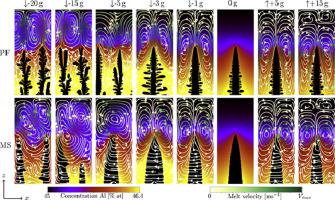当前位置:
X-MOL 学术
›
Acta Mater.
›
论文详情
Our official English website, www.x-mol.net, welcomes your
feedback! (Note: you will need to create a separate account there.)
Mesoscopic modeling of equiaxed and columnar solidification microstructures under forced flow and buoyancy-driven flow in hypergravity: envelope vs. phase-field model
Acta Materialia ( IF 8.3 ) Pub Date : 2020-10-01 , DOI: 10.1016/j.actamat.2020.07.069 Alexandre Viardin , Youssef Souhar , Martín Cisternas Fernández , Markus Apel , Miha Založnik
Acta Materialia ( IF 8.3 ) Pub Date : 2020-10-01 , DOI: 10.1016/j.actamat.2020.07.069 Alexandre Viardin , Youssef Souhar , Martín Cisternas Fernández , Markus Apel , Miha Založnik

|
Abstract Quantitative modeling of solidification microstructures growing under the influence of convection is a challenging multiscale problem. It is of particular interest in processes where strong flow is present, such as centrifugal casting of Ti–Al alloys, where hypergravity strongly reinforces the buoyancy-driven flow. We present the coupling of the mesoscopic envelope model for dendritic solidification with fluid flow. We use the model to investigate columnar and equiaxed dendritic growth of the β-solidifying Ti–45 at.%Al under the influence of flow. The calculations are compared to phase-field results in 2D. For equiaxed growth the case of forced flow is treated. For columnar growth, the influence of buoyancy-driven flow on the growing structure and on the primary dendrite arm spacing is characterized for gravity levels ranging from 0 to ± 15 g. The computational cost of the mesoscopic simulations is around two orders of magnitude lower than that of phase field. We show that the mesoscopic model can accurately reproduce the microstructure characteristics, such as grain shape and primary arm spacing (PDAS), as long as the dendrite tip remains parabolic. When flow effects in columnar growth are strong enough to change the tip shape and induce tip splitting events, the mesoscopic envelope model does not reproduce the resulting branched microstructures. It does however predict the corresponding PDAS reduction at the correct gravity level.
中文翻译:

超重力下强迫流动和浮力驱动流动下等轴和柱状凝固微观结构的细观建模:包络线与相场模型
摘要 在对流影响下生长的凝固微观结构的定量建模是一个具有挑战性的多尺度问题。它在存在强流动的过程中特别有趣,例如 Ti-Al 合金的离心铸造,其中超重力强烈增强了浮力驱动的流动。我们提出了用于树枝状凝固的细观包络模型与流体流动的耦合。我们使用该模型研究了流动影响下 β 凝固 Ti-45 at.%Al 的柱状和等轴枝晶生长。计算结果与 2D 中的相场结果进行比较。对于等轴生长,处理强制流动的情况。对于柱状生长,浮力驱动流动对生长结构和初级枝晶臂间距的影响特征在于重力水平范围为 0 到 ± 15 g。细观模拟的计算成本比相场低两个数量级左右。我们表明,只要枝晶尖端保持抛物线形,细观模型就可以准确再现微观结构特征,例如晶粒形状和主臂间距 (PDAS)。当柱状生长中的流动效应强到足以改变尖端形状并引起尖端分裂事件时,细观包络模型不会重现产生的分支微结构。然而,它确实预测了在正确的重力水平下相应的 PDAS 减少。细观模拟的计算成本比相场低两个数量级左右。我们表明,只要枝晶尖端保持抛物线形,细观模型就可以准确再现微观结构特征,例如晶粒形状和主臂间距 (PDAS)。当柱状生长中的流动效应强到足以改变尖端形状并引起尖端分裂事件时,细观包络模型不会重现产生的分支微结构。然而,它确实预测了在正确的重力水平下相应的 PDAS 减少。细观模拟的计算成本比相场低两个数量级左右。我们表明,只要枝晶尖端保持抛物线形,细观模型就可以准确再现微观结构特征,例如晶粒形状和主臂间距 (PDAS)。当柱状生长中的流动效应强到足以改变尖端形状并引起尖端分裂事件时,细观包络模型不会重现产生的分支微结构。然而,它确实预测了在正确的重力水平下相应的 PDAS 减少。当柱状生长中的流动效应强到足以改变尖端形状并引起尖端分裂事件时,细观包络模型不会重现产生的分支微结构。然而,它确实预测了在正确的重力水平下相应的 PDAS 减少。当柱状生长中的流动效应强到足以改变尖端形状并引起尖端分裂事件时,细观包络模型不会重现产生的分支微结构。然而,它确实预测了在正确的重力水平下相应的 PDAS 减少。
更新日期:2020-10-01
中文翻译:

超重力下强迫流动和浮力驱动流动下等轴和柱状凝固微观结构的细观建模:包络线与相场模型
摘要 在对流影响下生长的凝固微观结构的定量建模是一个具有挑战性的多尺度问题。它在存在强流动的过程中特别有趣,例如 Ti-Al 合金的离心铸造,其中超重力强烈增强了浮力驱动的流动。我们提出了用于树枝状凝固的细观包络模型与流体流动的耦合。我们使用该模型研究了流动影响下 β 凝固 Ti-45 at.%Al 的柱状和等轴枝晶生长。计算结果与 2D 中的相场结果进行比较。对于等轴生长,处理强制流动的情况。对于柱状生长,浮力驱动流动对生长结构和初级枝晶臂间距的影响特征在于重力水平范围为 0 到 ± 15 g。细观模拟的计算成本比相场低两个数量级左右。我们表明,只要枝晶尖端保持抛物线形,细观模型就可以准确再现微观结构特征,例如晶粒形状和主臂间距 (PDAS)。当柱状生长中的流动效应强到足以改变尖端形状并引起尖端分裂事件时,细观包络模型不会重现产生的分支微结构。然而,它确实预测了在正确的重力水平下相应的 PDAS 减少。细观模拟的计算成本比相场低两个数量级左右。我们表明,只要枝晶尖端保持抛物线形,细观模型就可以准确再现微观结构特征,例如晶粒形状和主臂间距 (PDAS)。当柱状生长中的流动效应强到足以改变尖端形状并引起尖端分裂事件时,细观包络模型不会重现产生的分支微结构。然而,它确实预测了在正确的重力水平下相应的 PDAS 减少。细观模拟的计算成本比相场低两个数量级左右。我们表明,只要枝晶尖端保持抛物线形,细观模型就可以准确再现微观结构特征,例如晶粒形状和主臂间距 (PDAS)。当柱状生长中的流动效应强到足以改变尖端形状并引起尖端分裂事件时,细观包络模型不会重现产生的分支微结构。然而,它确实预测了在正确的重力水平下相应的 PDAS 减少。当柱状生长中的流动效应强到足以改变尖端形状并引起尖端分裂事件时,细观包络模型不会重现产生的分支微结构。然而,它确实预测了在正确的重力水平下相应的 PDAS 减少。当柱状生长中的流动效应强到足以改变尖端形状并引起尖端分裂事件时,细观包络模型不会重现产生的分支微结构。然而,它确实预测了在正确的重力水平下相应的 PDAS 减少。











































 京公网安备 11010802027423号
京公网安备 11010802027423号